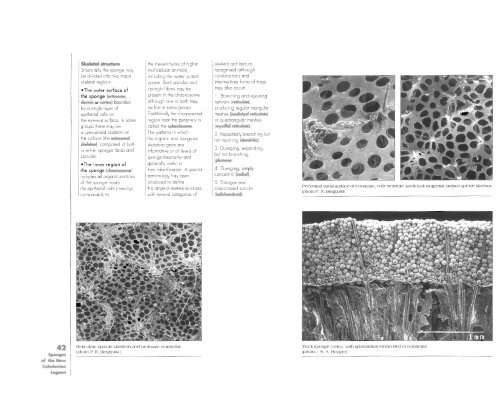Sponges of the New Caledonian lagoon - IRD
Sponges of the New Caledonian lagoon - IRD
Sponges of the New Caledonian lagoon - IRD
You also want an ePaper? Increase the reach of your titles
YUMPU automatically turns print PDFs into web optimized ePapers that Google loves.
42<br />
<strong>Sponges</strong><br />
<strong>of</strong> <strong>the</strong> <strong>New</strong><br />
<strong>Caledonian</strong><br />
Lagoan<br />
Skeletal structure<br />
Structurally <strong>the</strong> sponge may<br />
be divided into two maiar<br />
skeletal regions:<br />
- The outer surface <strong>of</strong><br />
<strong>the</strong> sponge lectosome,<br />
dermis or cortex) bounded<br />
by a single layer <strong>of</strong><br />
epi<strong>the</strong>lial cells on<br />
<strong>the</strong> external surface. In same<br />
groups <strong>the</strong>re may be<br />
a specialised skeleton on<br />
<strong>the</strong> surface [<strong>the</strong> ectosomal<br />
skeleton!, composed <strong>of</strong> bath<br />
or ei<strong>the</strong>r spongin fibres and<br />
spicules.<br />
-The inner region <strong>of</strong><br />
<strong>the</strong> sponge (choanosomel<br />
includes all organic partians<br />
<strong>of</strong> <strong>the</strong> sponge inside<br />
<strong>the</strong> epi<strong>the</strong>lial cells (mesohyl,<br />
comparable to<br />
<strong>the</strong> mesenchyme <strong>of</strong> higher<br />
multicellular animals!,<br />
including <strong>the</strong> water current<br />
system. Bath spicules and<br />
spongin fibres may be<br />
present in <strong>the</strong> chaanosome,<br />
although one or bath may<br />
be lost in same groups.<br />
Traditionally <strong>the</strong> chaanosamal<br />
region near <strong>the</strong> periphery is<br />
called <strong>the</strong> subeetosome.<br />
The patterns in which<br />
<strong>the</strong> organic and inorganic<br />
skeletons grow are<br />
informative at all levels <strong>of</strong><br />
sponge taxonomy and<br />
generally useful in<br />
<strong>the</strong>ir identification. A special<br />
terminology has been<br />
produced to define<br />
this range <strong>of</strong> skeletal structures,<br />
with several categories <strong>of</strong><br />
Reticulate spicule skeleton and perforate ectO$ome<br />
(photo P.R. Bergquist)<br />
skeletal architecture<br />
recognised lalthaugh<br />
combinations and<br />
intermediate farms <strong>of</strong> <strong>the</strong>se<br />
may also occur!.<br />
I Branching and rejoining<br />
network Ireticulate!,<br />
producing regular triangular<br />
meshes [isodictyal rericulatel<br />
or quadrangular meshes<br />
(myxillid rericulatel<br />
2. Repeatedly branching but<br />
not rejoining (dendriricl<br />
3. Diverging, expanding,<br />
but not branching<br />
[plumosel.<br />
4. Diverging, simply<br />
concentric (radial).<br />
S. Disorganised<br />
criss-crossed spicule<br />
[halichondroidj<br />
Perforated ostial surface <strong>of</strong> ectosame, with renieraid (isodicryal) tangential surface spicule skeleran<br />
(photo P. R. Bergquist)<br />
ThiCk sponge cortex. with spherasters embedded in ectasame<br />
(photo J. N. A. Hooper)

















